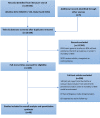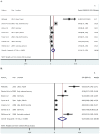Global birth prevalence and mortality from inborn errors of metabolism: a systematic analysis of the evidence
- PMID: 30479748
- PMCID: PMC6237105
- DOI: 10.7189/jogh.08.021102
Global birth prevalence and mortality from inborn errors of metabolism: a systematic analysis of the evidence
Abstract
Background: Inborn errors of metabolism (IEM) are a group of over 500 heterogeneous disorders resulting from a defect in functioning of an intermediate metabolic pathway. Individually rare, their cumulative incidence is thought to be high, but it has not yet been estimated globally. Although outcomes can often be good if recognised early, IEM carry a high fatality rate if not diagnosed. As a result, IEM may contribute significantly to the burden of non-communicable childhood morbidity.
Methods: We conducted a systematic literature review of birth prevalence and case fatality of IEM globally, with search dates set from 1980 to 2017. Using random-effects meta-analysis, we estimated birth prevalence of separate classes of IEM and all-cause IEM, split by geographical region. We also estimated levels of parental consanguinity in IEM cases and global case fatality rates and resultant child deaths from all-cause IEM.
Findings: 49 studies met our selection criteria. We estimate the global birth prevalence of all-cause IEM to be 50.9 per 100 000 live births (95% confidence intervals (CI) = 43.4-58.4). Regional pooled birth prevalence rates showed the highest rates of IEM to be in the Eastern Mediterranean region (75.7 per 100 000 live births, 95% CI = 50.0-101.4), correlating with a higher observed rate of parental consanguinity in studies from this area. We estimate case fatality rates to be 33% or higher in low- and middle-income countries (LMICs), resulting in a minimum of 23 529 deaths from IEM per year globally (95% CI = 20 382-27 427), accounting for 0.4% of all child deaths worldwide.
Conclusions: IEM represent a significant cause of global child morbidity and mortality, comprising a notable proportion of child deaths currently not delineated in global modelling efforts. Our data highlight the need for policy focus on enhanced laboratory capacity for screening and diagnosis, community interventions to tackle parental consanguinity, and increased awareness and knowledge regarding management of IEM, particularly in LMICs.
Conflict of interest statement
Declaration of interest: Igor Rudan is the Co-Editor in Chief of the Journal of Global Health. To ensure that any possible conflict of interest relevant to the journal has been addressed, this article was reviewed according to best practice guidelines of international editorial organizations. The authors completed the Unified Competing Interest form at www.icmje.org/coi_disclosure.pdf (available on request from the corresponding author). The authors declare no competing interests.
Figures





References
-
- Seymour CA, Thomason MJ, Chalmers RA, Addison GM, Bain MD, Cockburn F, et al. Newborn screening for inborn errors of metabolism: a systematic review. Health Technol Assess. 1997;1:i–iv, 1-95. - PubMed
Publication types
MeSH terms
LinkOut - more resources
Full Text Sources
Medical
Research Materials
Miscellaneous
